The other night, I was almost able to cross something off my bucket list: watching a film all by myself in an otherwise empty movie theater. Save for one other couple, I sat alone in the final screening of Roma Downey’s recent blockbuster, Son of God, at my local cinema.
This was at least partially calculated. Having already seen a good portion of The Bible miniseries (we’ve even used bits of it in my classes at times), I had a good idea what I was in store for – I didn’t want to disrespectfully subject a crowd of devout Christians to my chortling at the strange choices made when adapting the biblical stories to the big screen. It always happens: Jesus is a strangely white, Zen hippie character with a European accent and a dazed expression; the violence and gore is exaggerated at the expense of the important doctrinal bits that make people uncomfortable; Mary is emphasized; Veronica appears; anachronisms abound – the list goes on.
This time, though, something extremely troubling was all but left out – an omission, if we’re to take the apostle Paul’s word on the matter, that makes everything else in the movie a pathetic waste of time.
It wasn’t all bad though – I actually only burst out laughing three times - so, here are some positive and negative observations about the Son of God film, structured in the classic spaghetti-western style.
Because spaghetti is at least as applicable to 1st century Judaism as is folding your hands and bowing your head to pray.
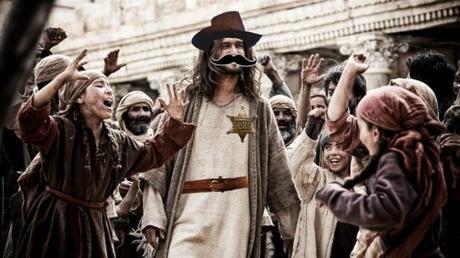
The Good
The Political Games
- The power struggle between Caiaphas, the High Priest, and Pontius Pilate, the governor, was very nicely captured. The shuffling of Jesus back and forth between Jewish jurisdiction and Roman executioners was fairly easy to follow (though this was partially because of one thing I’ll mention in the next section). Regardless, it was clear that both men were trying to make the other one deal with their mutual problem, Jesus, while trying to keep their own hands as clean as possible. In the end, both are properly made out to be very guilty.
Several Minor Characters
- Nicodemus in particular stands out as an excellent supporting character, even though the movie makes him more sympathetic to Jesus’ message than the Bible indicates (unless I missed it, Nicodemus does not vote – in the film – to condemn Jesus at his illegal trial). Also, Barabbas’ interactions with Christ in the scenes leading up to he and Jesus being presented to the crowd were interesting – as was Barabbas’ arrogant-turned-humble reaction to being freed after he locks eyes with Christ.
Strategic Cuts and Juxtapositions
- On the structural level, the film editors made several clever choices to juxtapose various characters. For example, Judas goes to meet with Caiaphas while Nicodemus meets with Jesus at night and hears the famous John 3:16. Even though these two events are not clearly linked in the text, this editing choice helped to demonstrate (rather than simply state) some of the motivations of these secondary characters and contrast two people who “switched sides,” as it were. Later, Jesus’ prayers in Gethsemane are repeatedly intercut with scenes of both Caiaphas and the priests praying in the temple and Pilate and Claudia praying before an unnamed idol, further contrasting the three competing worldviews at play in the story. Adapting prose to a visual medium allows for certain clever demonstrative possibilities of which, I’m quite to say, the filmmakers took ample advantage.
The Bad
Hippie Jesus
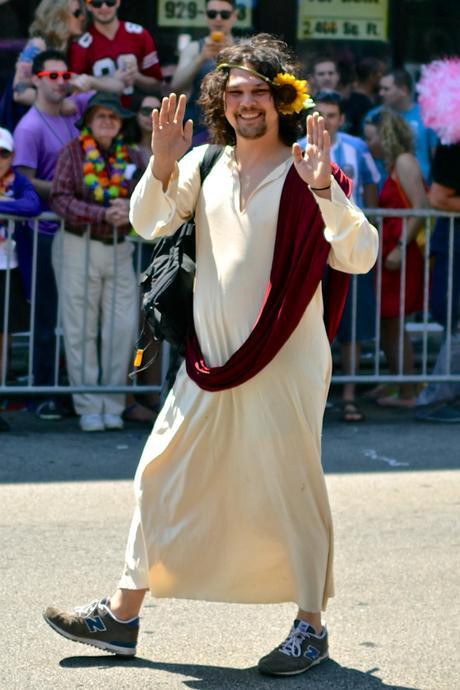 This is interpretation of Jesus’ character is certainly not unique to Son of God, but Diogo Morgado’s presentation of Christ as a mystical, perpetually out-of-breath, long-haired dude who has a penchant for staring off into the distance with a vague smile on his face is especially strong. Sexy Zen Jesus never gets mad (when he turns over the tables in the temple he seems stoned, not angry, and there’s no whip in sight) and always seems ready to dish out the hugs. More seriously, the decision to give Jesus flashes of insight from God seriously limit the portrayal of His communion with the Father; for example, the fact that Jesus seems genuinely surprised by His vision of Peter’s upcoming denial – while possibly within the orthodox boundaries of the kenotic Incarnation – still made Jesus appear far more flawed than seems appropriate.
This is interpretation of Jesus’ character is certainly not unique to Son of God, but Diogo Morgado’s presentation of Christ as a mystical, perpetually out-of-breath, long-haired dude who has a penchant for staring off into the distance with a vague smile on his face is especially strong. Sexy Zen Jesus never gets mad (when he turns over the tables in the temple he seems stoned, not angry, and there’s no whip in sight) and always seems ready to dish out the hugs. More seriously, the decision to give Jesus flashes of insight from God seriously limit the portrayal of His communion with the Father; for example, the fact that Jesus seems genuinely surprised by His vision of Peter’s upcoming denial – while possibly within the orthodox boundaries of the kenotic Incarnation – still made Jesus appear far more flawed than seems appropriate.
Also, Morgado’s line delivery was often quite strange in a staggered, uncertain method that combined two parts “English is not my first language,” one part “I forgot my lines,” and one part “William Shatner’s Captain Kirk.” Nevermind how much Jesus did not look Jewish; he didn’t even sound human.
The Creepy Bedtime Story
- One jarring example of Morgado-Jesus’ unnatural line delivery was so bad that it deserves its own bullet point. Towards the end of the book of Matthew, Jesus grieves over the coming destruction of Jerusalem and God’s temple. It’s a very emotional scene in the Bible: Jesus has just been passionately arguing with the religious leaders (Matt. 23) and as he and the apostles leave the temple Jesus prophesies that the buildings they are surrounded by will be rent to the ground. He clearly does not take joy in the thought (to put it lightly) – except in the film, where Jesus happily makes this same prophecy to a little girl in a sing-song voice while smiling and patting her on the head. This was one place that I literally burst out laughing in the theater.
Sympathetic Judas
- A second place that provoked me to laughter (albeit, of a more bitter sort) was the movie’s treatment of Judas Iscariot. While the gospels admittedly don’t give us much of a window into Judas’ motivations in his betrayal of his friend and teacher, Son of God strongly suggests that Judas was more of a bumbling lackey who Caiaphas manipulated, rather than a man who willfully chose to do what he did. Interestingly, the film tries to stay true to both John 13 – where Jesus places a morsel of bread into Judas’ mouth – and Catholic dogma – where the Son of Perdition (John 17:12) could not possibly receive the holy elements of the Eucharist – by having Judas puke up his Last Supper as he runs away from the meal. I tried to fight it, but I too felt something coming up uncontrollably at that scene: some giggles.
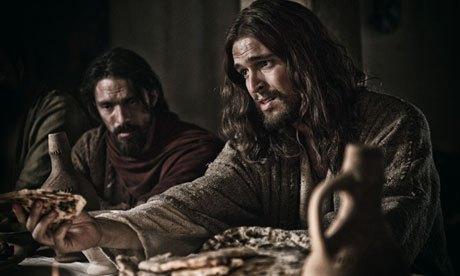
Fictional Additions
- It’s unsurprising that a Catholic production would rely on church tradition even when Scripture says otherwise (or is silent), but some of the additions to Son of God cannot be excused even on those grounds. As mentioned already, turning the Last Supper into the First Communion service, though unbiblical, might serve some educational point, but Pilate’s threat to close the temple and cancel Passover is something quite different. That fictional element to the tale serves more like scaffolding built up to support the genuine narrative (for it did serve to heighten the tension between Pilate and Caiaphas), but at the expense of obscuring the actual structure of the story (it almost justifies Caiaphas’ harsh response to Jesus’ presence in Jerusalem at Passover). Obviously, other unhistorical additions – like Mary’s or Veronica’s appearances on the Via Dolorosa – fall into this same category.
No Satan
- Strangely, the Devil makes no appearance in Son of God, despite showing up repeatedly throughout The Bible miniseries. This might be more of an aesthetic disagreement, but I found it unfortunate. On one hand, it did serve to forcibly lay the blame for the matter of Jesus’ death squarely on the shoulders of the Jewish and Roman authorities, but it seems like it would have offered another layer of meaning to at least have Satan watching the events unfold from the back of the crowd (as he did in the miniseries). Apparently, this is all Glenn Beck’s fault (or something), since the producers didn’t want the silly “Satan-looks-like-President-Obama” faux-controversy popping up again.
Anachronisms
- This may also be a small detail, but it was the third thing that actually prompted me to laugh in the theater: Jesus folded his hands and bowed his head to pray the Lord’s Prayer in precisely the way that a 1st-century Jew would not have prayed. This was doubly strange given the different prayer posture later demonstrated at the Last Supper. Most people wouldn’t notice, but this seems to evidence at least a partial motivation to anachronistically map contemporary practices backwards onto ostensibly historical portrayals. Oh, and everyone’s got a profound European accent (mostly English, though Jesus’ was Portuguese).
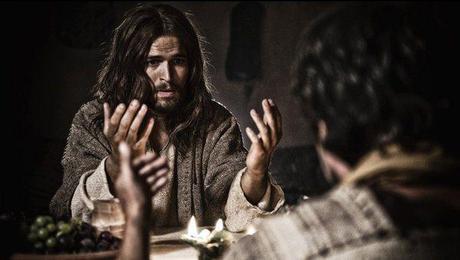
The Ugly
Selective Quoting
- Many Christians who are familiar with John’s Gospel – the go-to text for the scriptwriters of Son of God – were likely surprised at a jarring omission from a particularly famous Bible verse:
5 “Thomas said to him, “Lord, we do not know where you are going. How can we know the way?” 6 Jesus said to him, “I am the way, and the truth, and the life. No one comes to the Father except through me.” (John 14:5-6, ESV)
When the film’s Jesus replies to Thomas’ question at the Last Supper, he – almost inexplicably – forgets that final sentence. When Peter later repeats the quote (as he’s leading the apostles in an observation of the Eucharist that we’ll consider shortly), he again fails to include the full verse. For many who know this famous description of the importance of Jesus’ ministry and resurrection, as well as the specification of Jesus’ unique saving power, its omission was a significant sour note.
One can only speculate, but I cannot help but wonder if this was motivated – like the deletion of Satan – by another desire to avoid controversy, this time of the “intolerance” sort. This controversy, however, seems awfully necessary.
No Call to Repent
- In a similar fashion, the Son of God film never has Jesus calling for anyone to repent of their sins. Unless I blinked for too long, Jesus never even speaks the word “repent,” despite it being a common call of His throughout the gospels. Granted, John’s gospel tends to focus more on a call to “believe” (which the film certainly ran with), but apart from His healing the paralyzed man lowered through the roof, I don’t recall hearing Jesus even mention the word “sin” – which seems like a terrible lost opportunity, if not another glaring omission.
Step one to fixing the problem is recognizing that there is a problem to be fixed, right?
No Clear Bodily Resurrection
- But, by far, the most glaring problem with this film was its very watered-down presentation of Jesus’ resurrection – so underplayed, in fact, that it was not altogether clear that Jesus was, in fact, literally physically resurrected from the dead. Consider the following points:
- When Peter, John, and Mary find the empty tomb, Peter exclaims “He’s back!” not the far more specific (and doctrinally correct) “He’s alive!” “Back” could carry a wide range of meanings that do not fully capture the physical, bodily return of Jesus to life from the grave.
- The first time that the apostles meet Christ post-resurrection was within the context of an impromptu Eucharist observation. Indeed, Peter’s urgency to find bread and wine (instead of, say, Jesus’ living body) was terribly odd, but it worked: just as the first Bishop of Rome blesses the elements, Jesus magically walks through the door. The symbolism to our Catholic friends is quite clear: Christ is understood to be literally present within the Communion elements, so too in the film is he literally present with the apostles as he walks through the door. But there is no clear affirmation of Jesus’ conquering death here – the scene makes equal sense if you assume that the apostles are seeing a vision of Jesus, an apparition of Jesus (a la docetic teachings), or simply hallucinating. The fact that Jesus does not place Thomas’ fingers or hands into His healed wounds does not help. Indeed, by any denominational standard, if there was any time that the Eucharist would be completely unnecessary, it was during the 40 days between the Resurrection and the Ascension when Christ was still physically present on Earth!
- While the film does rightfully note that Jesus’ ascension did not take place until 40 days after his resurrection, said ascension is portrayed more like a Star Trek transporter beam than the physical levitation of Jesus’ body into the sky that we see in Acts 1. Ambiguity abounds.
- The final scene sees the apostle John being reunited with Jesus on the isle of Patmos, but the film fails to present either a natural human response to the mode of Jesus’ appearance or the biblical account of Jesus’ actual apocalyptic appearance. If one wanted to be true to the latter, Jesus would have appeared in a much more glorious fashion than the movie displayed, but to be true to the former would require John doing more than simply staring into the distance and crying. Once again, it seemed more like lonely, old John was having a vision of his old friend (simultaneously mouthing the words that vision-Jesus was speaking) than it seemed like the physically resurrected Jesus had shown up again.
When it comes to Christ’s resurrection, there is no greater point to be argued than the fact that it literally happened in the very flesh of his body – Paul makes this point explicitly in 1 Corinthians 15:
12 Now if Christ is proclaimed as raised from the dead, how can some of you say that there is no resurrection of the dead? 13 But if there is no resurrection of the dead, then not even Christ has been raised. 14 And if Christ has not been raised, then our preaching is in vain and your faith is in vain.15 We are even found to be misrepresenting God, because we testified about God that he raised Christ, whom he did not raise if it is true that the dead are not raised. 16 For if the dead are not raised, not even Christ has been raised. 17 And if Christ has not been raised, your faith is futile and you are still in your sins. 18 Then those also who have fallen asleep in Christ have perished. 19 If in Christ we have hope in this life only, we are of all people most to be pitied.
20 But in fact Christ has been raised from the dead, the firstfruits of those who have fallen asleep.21 For as by a man came death, by a man has come also the resurrection of the dead. 22 For as in Adam all die, so also in Christ shall all be made alive.” (1 Cor. 15:12-21, ESV)
For a movie that purports to be telling the greatest story ever told, it fails to clearly underline the reality of its most important point: that Jesus died, but did not stay that way – he conquered death and, in so doing, paved the way for the rest of us to follow. If Christ simply “is back” in a metaphorical sense or within the elements of the Lord’s Table (which is the most clear point that this movie makes), then Paul would laugh at the patheticness of that weakened gospel.
Simply making the Jesus actor walk back on screen with holes in his hands is not enough to make this point explicit – especially not in consort with all the rest of this mess.
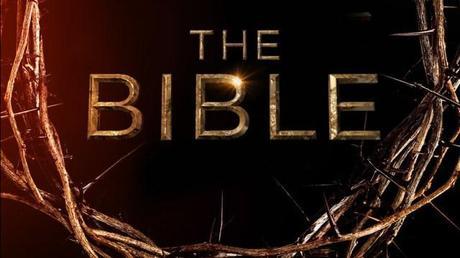 This is not to say that this movie, or the miniseries that spawned it, is impossibly flawed – anytime a story is adapted into a different medium certain bits of it must be changed – though, as is usual with any adaptation, I found the book to be far better. It is strange, though, that whereas changes to an original will incite metaphorical riots amongst the ranks of Tolkien followers or Harry Potter readers, Christians tend to give a pass to the filmmakers of biblical stories because “at least the message is getting out”. As has been shown, that is not necessarily the case.
This is not to say that this movie, or the miniseries that spawned it, is impossibly flawed – anytime a story is adapted into a different medium certain bits of it must be changed – though, as is usual with any adaptation, I found the book to be far better. It is strange, though, that whereas changes to an original will incite metaphorical riots amongst the ranks of Tolkien followers or Harry Potter readers, Christians tend to give a pass to the filmmakers of biblical stories because “at least the message is getting out”. As has been shown, that is not necessarily the case.
What we certainly must avoid, then, is thinking that a movie ever accurately portrays the Bible without incorporating some artistic license into the telling. Too many of my students were walking into my class saying that they “had never seen the story of Jesus quite so clearly” – unfortunately, they still haven’t. What we can do, though, is use movies like this – or the upcoming Noah adaptation with Russell Crowe or Exodus story with Christian Bale – as springboards for deeper conversations. This is how we’ve used The Bible miniseries in my Christian Education classes: we’ll show a clip to introduce a story, read the actual story, and discuss where the stories converge and diverge. Certainly, the production value of The Bible is excellent and, within the context of a guided discussion, can help to present biblical, historical truth. Sometimes, we can be quite impressed with how certain bits are faithfully presented or accurately captured.
And sometimes we all just have to take a moment to laugh.
Tags: Christianity, Jesus, Jesus Movie, Resurrection, Sexy Zen Jesus, Son of God, The Bible, The Bible Miniseries